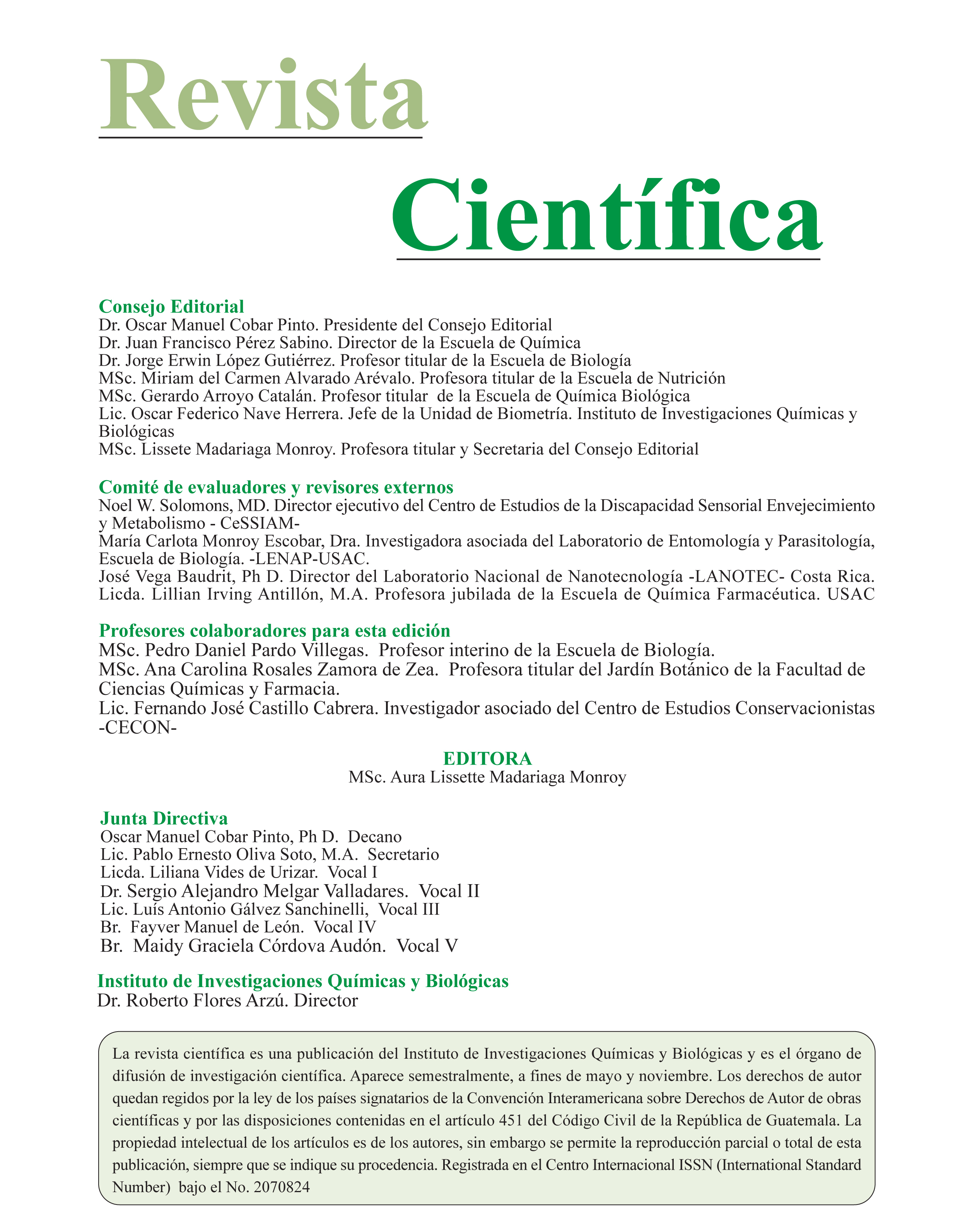Estado de salud de los habitantes de las aldeas Monterrico y La Candelaria, Taxisco, Santa Rosa, Guatemala
DOI:
https://doi.org/10.54495/Rev.Cientifica.v23i1.112Palabras clave:
agua de pozo, anemia, estado de salud, indicadores de salud, dermatofitos, anticuerpos contra H. pylori y anticuerpos contra dengueResumen
Con el propósito de establecer el estado de salud de los habitantes de las aldeas Monterrico y La Candelaria, Taxisco, Santa Rosa en Guatemala, se evaluaron los siguientes indicadores de salud: calidad microbiológica del agua de los pozos de las viviendas de las aldeas, análisis de malaria y anemia, infecciones de los pies por hongos dermatofitos, prevalencia de anticuerpos contra dengue (IgG e IgM) y prevalencia de anticuerpos contra Helicobacter pylori (IgG) en los habitantes de las viviendas, e índice de masa corporal (IMC) y presencia de parásitos intestinales en escolares. La obtención de muestras y recolección de datos se realizó en ambas aldeas mediante un diseño aleatorio por conglomerados, donde se seleccionaron 26 casas en la aldea La Candelaria y 30 casas de la aldea Monterico, incluyendo en el estudios todos los habitantes de dichas viviendas. Los resultados indicaron contaminación por coliformes totales en los pozos de ambas aldeas en una proporción de 70% en La Candelaria y 80% en Monterrico así como contaminación por coliformes fecales en un 30% en la aldea La Candelaria y 53.3% en Monterrico. La frecuencia de infecciones por hongos dermatofitos fue de 34.2% en Monterrico y 37.1% en La Candelaria y la presencia de parásitos intestinales en escolares fue de 13.6% en Monterrico y de 18.7% en La Candelaria, indicando deficientes niveles de salud comunitaria. La prevalencia de dengue en la comunidad fue establecida como equivalente a la que se presenta en otras regiones del país, no así la prevalencia de anticuerpos contra Helicobacter pylori, que resultó por debajo de los niveles demostrados en otras poblaciones. Se pudo constatar así mismo, que las medidas preventivas en contra de la malaria han sido efectivas en ambas aldeas pues no se evidenció ningún caso positivo. Este estudio contribuye con las comunidades de las aldeas de Monterrico y La Candelaria, brindando conocimiento del estado de salud de sus habitantes el cual podrá servir para planificar medidas de intervención y realizar un monitoreo de las condiciones de salud en las aldeas.
Descargas
Citas
Anacleto, F., (2007). Calidad Microbioógica del Agua de Consumo Humano de Tres Comunidades Rurales del Sur de Sonora. Revista Salúd Pública y Nutrición. Vol 8:3.
Behrman, R. (2004). Nelson Tratado de Pediatría. España: Editorial Elsevier
Cifuentes, G., Silvestre, Y., Lange, K. y Matta, V. (2012). Frecuencia de anticuerpos IgG anti Helicobacter pylori en expendedores de alimentos de la ciudad universitaria, zona 12. Revista Científica, 22(1), 24-29. https://doi.org/10.54495/Rev.Cientifica.v22i1.119
Coma J. y Bonet J., (2004). Producción ganadera y contaminación ambiental. XX Curso de Especialización FEDNA.Barcelona. Grupo Vall Companys.
INE. (2009). Población y locales de habitación particulares censados según departamento y municipio. Guatemala. 38 pp.
Jiménez R. (2008). Malaria en España: aspectos entomológicos y perspectivas de futuro. Revista Española de Salud Pública. 82(5). https://doi.org/10.1590/S1135-57272008000500003
Lange, K., Matta, V., Nave, F., Alvarado, V.,Camo, M., et al. Frecuencia de anticuerpos IgM e IgG anti Helicobacter pylori en estudiantes, personal docente y administrativo de la Facultad de Ciencias Químicas y Farmacia. Revista Científica, 20(1), 96-101.
Mahan, K. y Escott, S. (2000). Nutrición y dietoterapia de Krause. México, McGraw-Hill. 1274 p
Mogollón, D. (2001). Factores condicionantes del estado nutricional de la población preescolar que asiste a la escuela parvularia “Demetria Linares” de la cabecera departamental de Sololá. Tesis médico y cirujano. Universidad de San Carlos de Guatemala.
Organización Panamericana del a Salud/Organización Mundial de la Salud. (2008). Desnutrición Infantil en las Américas: Cumplimiento de los Objetivos de Desarrollo del Milenio. Washington DC: WHO.
Perea, S., et al. (2000). Prevalence and risk factors of tinea unguium and tinea pedís in the general population in Spain. Clinical Microbiology. 38: 3226-30. https://doi.org/10.1128/JCM.38.9.3226-3230.2000
Pérez C, M. et al. (2007).Intervención educativa y parasitismo intestinal en niños de la enseñanza primaria. Revista Cubana de Medicina General Integral. 23(2)
Programa de vectores, D. g. (2007). Proyecto de la Iniciativa Multisectorial para Reducir la Malaria en Cinco áreas Prioritarias de Guatemala. Manual Operativo para la Vigilancia y Control de las Fases Inmaduras de los Vectores de Malaria en Guatemala., Ministerio de Salud Públicay Asistencia Social, pp. 11-13.
Sánchez-Pérez, H.J. M.G. Vargas-Morales y J. D. Méndez-Sánchez, (2000). Calidad bacteriológica del agua para consumo humano en zonas de alta marginación de Chiapas. Revista Salud Pública de México. 42 (5), 397-406. https://doi.org/10.1590/S0036-36342000000500005
Descargas
Publicado
Cómo citar
Número
Sección
Licencia
Derechos de autor 2013 V. Gallardo, E. Albanés, D. Rivera, C. Flores, O. Vásquez, M. Ruano, E. Alvarado, A. Muñoz, A. Chiguaque, B. Recinos, A. Diaz, D. Ortiz, G. Arroyo

Esta obra está bajo una licencia internacional Creative Commons Atribución 4.0.
Los autores/as que publiquen en esta revista aceptan las siguientes condiciones:
- Los autores/as conservan los derechos de autor y ceden a la revista el derecho de la primera publicación, con el trabajo registrado con la licencia de atribución de Creative Commons 4.0, que permite a terceros utilizar lo publicado siempre que mencionen la autoría del trabajo y a la primera publicación en esta revista.
- Los autores/as pueden realizar otros acuerdos contractuales independientes y adicionales para la distribución no exclusiva de la versión del artículo publicado en esta revista (p. ej., incluirlo en un repositorio institucional o publicarlo en un libro) siempre que indiquen claramente que el trabajo se publicó por primera vez en esta revista.
- Se permite y recomienda a los autores/as a compartir su trabajo en línea (por ejemplo: en repositorios institucionales o páginas web personales) antes y durante el proceso de envío del manuscrito, ya que puede conducir a intercambios productivos, a una mayor y más rápida citación del trabajo publicado.









